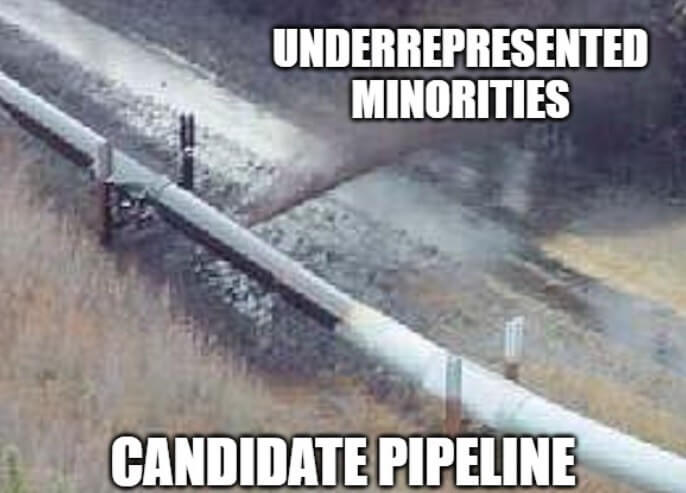Suggestions to reframe that always-erroneous statement and steps organizations can take to combat workplace -isms.
At the end of September, the CEO of Wells Fargo publicly stated the following:
“[T]he unfortunate reality,” he wrote, echoing comments he had made on a video call with employees, “is that there is a very limited pool of Black talent to recruit from.”
As should have been easily predicted, the backlash was both swift and brutal. It was then disclosed that seven high-ranking black women had quit Wells Fargo in the past year, citing gender and race issues in their decisions to leave.
The “pipeline” trope is the first (and sometimes last) stop for organizations that don’t care to look deeper at what the problem really is.
Because, of course, organizations generally do not want to admit publicly that they are part of the problem.
I don’t know anyone who HASN’T heard the “pipeline excuse” for lack of recruiting underrepresented minorities (URMs) of all categories, including people with disabilities. Note that I use a broader definition of URMs than the federal government, which limits the definition of URM to gender and ethnicity.
To me, a URM is someone who:
- identifies as a member of a minority group
- the minority group is underrepresented in the workplace.
Full stop. That includes status as a veteran, LGBTQ2+, caregiver, or person with a disability, as WELL as gender and ethnicity, to name a few of the potential categories.
Defining the lack of underrepresented minorities in terms of a “pipeline problem” implies that the fault lies elsewhere, and the organization can’t do anything to solve it.
Blaming someone else for the problem gives organizations permission to claim they are “doing the best they can under a bad set of circumstances.”
Reframe the problem already!

We don’t have an underrepresented minority pipeline problem. We do have:
- a racist, ableist, cisgender, white, male-dominated societal system;
- that is structured to work against specific disadvantaged groups of people (the underrepresented minorities);
- preventing the URMs from succeeding in the corporate world, and;
- the endemic levels of discrimination and exclusion have existed for so long, they have been normalized into societal context.
Mythbusting time: Organizations CAN do something about the “pipeline problem” that they claim they have, but first, the problem needs to be reframed and the organization needs to take responsibility for the aspects of the problem within their control and their lack of action in those areas.

Start with a “Five Whys” analysis
By performing a root cause analysis on your pipeline problem, you are flipping the narrative.
First why: Ask WHY you can’t get underrepresented minorities in your pipelines. The most common explanation is a lack of applicants.
Second why: Ask WHY you aren’t getting applicants?
- Is your organization looking in the right places?
- Are URM applicants being excluded by AI bias in your applicant tracking system?
- Are you taking care of your current URM employees, or are they saying, “yeah, I work there, but you don’t really want to be here with me” behind the scenes?
Third why: Why isn’t your organization looking in the right places?
Why are URM applicants being excluded in your applicant tracking system?
Why aren’t you taking care of your current URM employees?
…
And keep asking more “whys” until you have a list of actionable steps assigned to accountable parties that can be taken to help solve the issues that are PERCEIVED by the organization to be a “pipeline problem”.
Actionable Steps
Here are steps that any organization can take to improve their representation of URMs even if they haven’t done a five whys analysis.
- Have your organization rooted out your unconscious bias problem with your hiring managers?
- Have your organization solved the algorithmic bias created by your applicant tracking system?
- Has your organization created a culture of inclusion where URMs feel comfortable disclosing their status even when it can be hidden?
- Does your organization specifically reach out to groups where URMs congregate?
- If you want to reach women in tech, go to the Grace Hopper Conference.
- If you want to reach people with disabilities, reach out to disabled students’ organizations.
- If you want to reach neurodiverse candidates, work with organizations like Actually Autistic and Autism at Work.
Etc.
5. Did your organization take care of the URM employees that you have?
- Does your organization have mentorship / sponsorship / leadership / reverse mentoring opportunities for your current URM employees?
- Does your organization have retention plans specifically dealing with the issues facing URM employees?
- Does your organization have a retaliation-free complaint process? By this, I mean actually free of retaliation, not the useless “we don’t tolerate retaliation” wording that appears on every HR page when the reality is that almost half of EEOC complaints include retaliation claims.
6. Is your leadership all-white (or part-white/part-Asian in tech) and largely male?
7. Does your leadership’s action match the organization’s verbal claims?
8. Is your leadership is “doing diversity” or treating diversity and inclusion like an extracurricular activity?
9. Does your organization have a relationship with non Tier 1 universities and bootcamps?
10. Does your organization endow scholarships for underrepresented minorities?
11. Does your organization offer paid internships with a living wage?
12. Does the DEI (Disability, Equality, and Inclusion) part of your organization work take input from ERGs (Employee Resource Groups) and effect change to benefit URMs? Or does DEI expect the ERGs to drive change in a volunteer capacity with little to no power or spending authority?
13. Does your organization require interviewing a qualified URM candidate before making an offer to a non-diverse candidate? Emphasis on qualified, bringing someone in for an interview just so you can check that box when they are clearly not qualified to receive an offer, does NOT count.
14. Does your organization support your employees volunteering in educational settings?
Repeat after me — the pipeline problem is a myth.
Until organizations recognize that:
- The “pipeline problem” is a complete, self-delusional fantasy
- Perform a root cause / five whys analysis, and;
- Take steps to generate real change
numbers of employees that are URMs will continue to stagnate or even drop.
Don’t be a performative ally.
Do what needs to be done.

0 comments on “Can’t Find Underrepresented Minorities for Tech Jobs?”